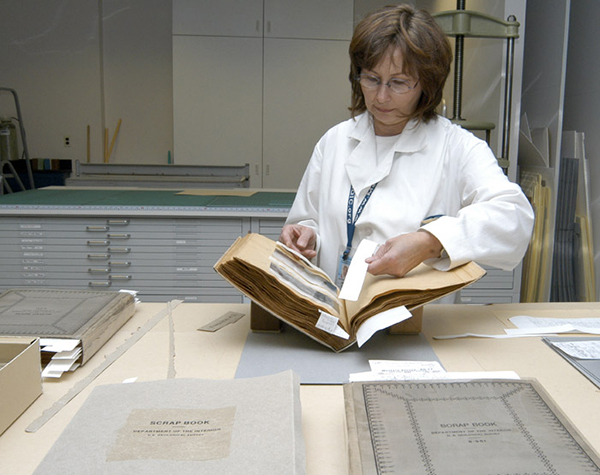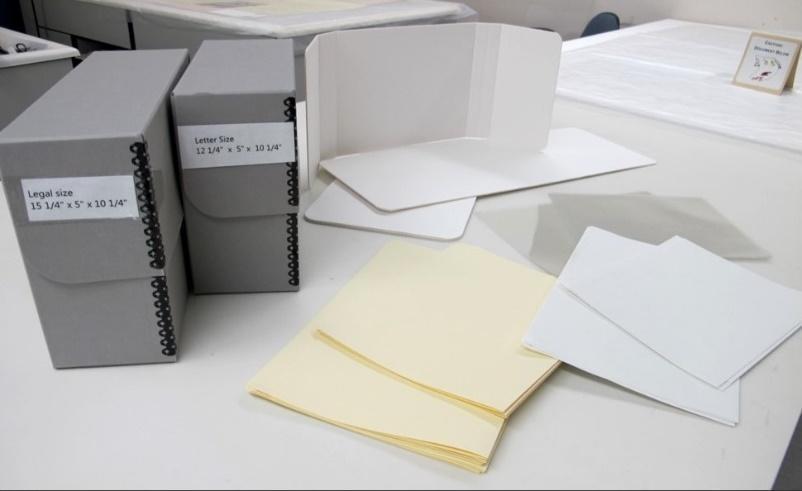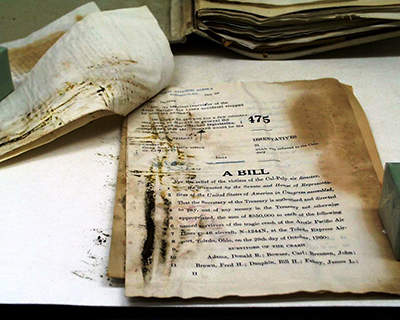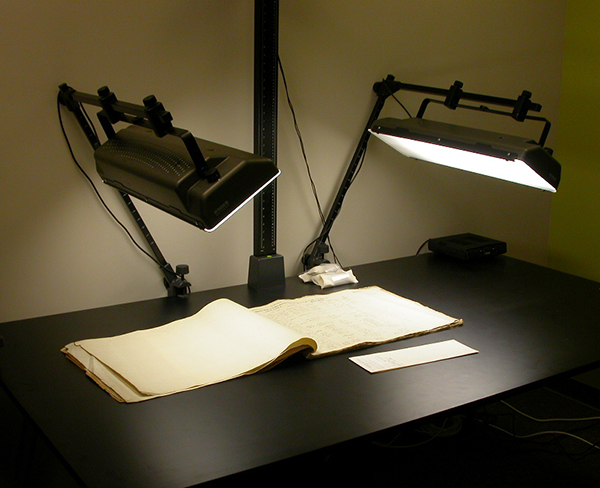
General Considerations for Rehousing and Preservation Processes
Before you begin: How to set up a holdings maintenance project.
- Assess Records for Holdings Maintenance
- Collect Supplies and Set Up a Work Area
- Hazardous Materials in Records
- Consider Preservation Reformatting
Assess Records for Holdings Maintenance
Review the condition of the records and make a plan before starting a holdings maintenance project.
- Records are prioritized for holdings maintenance based on archival significance, condition, and requested or anticipated use. Holdings maintenance is often incorporated into a processing, arrangement, and description project, and is undertaken to prepare records for efficient and safe digitization.
- The specific holdings maintenance actions carried out for any project are based on the condition of the records and the project objectives. Confirm the scope of the intended holdings maintenance; for instance, to provide minimal stabilization, or to thoroughly rehouse a collection.
- Before beginning a project, review the general condition of the records and their containers, and how easy it is to access and use the records to determine the best course of action. For one project, it may be appropriate to only label a box while for another it may be beneficial to refolder some of the records or carry out additional holdings maintenance actions.
Collect Supplies and Set Up a Work Area
Once you have determined which holdings maintenance actions are likely to be needed, prepare a work space and assemble the materials and supplies to carry out the work.
- Clear a work surface large enough to allow documents and folders to be opened fully and arranged if needed.
- Remove all food and drink, even water, from the work area to prevent accidental spillage.
- Handling with clean, bare hands is safest for textual records, which are the vast majority of holdings at the National Archives. Gloves can catch on paper records and reduce dexterity of the person handling the records. Nitrile gloves are used to handle still pictures, motion pictures, and some artifacts, such as metals, that are susceptible to damage by oils and salts from hands.
- Wash your hands before and after handling records and whenever they become soiled.
- Arrange supplies within easy reach. NARA provides a list of basic materials and supplies that are useful when carrying out rehousing records.
When replacing poor quality boxes and containers, use archival boxes, boards, folders, envelopes, and labels that meet specifications developed by NARA’s Heritage Science and Conservation branches.
- Specific brand names or supplies are not provided because manufacturers may change the composition of their products and vendors may change stock.
- Evaluate materials purchased for holdings maintenance to ensure that they meet archival standards. Compare the product literature to NARA specifications. Materials that have passed the ISO Standard 18916 known as the PAT (Photographic Activity Test) are usually good choices for archival preservation, especially for use with photographic materials. Refer to the Image Permanence Institute’s Photo Storage, Display, & Labelingguide.
- Plastic boxes and enclosures made of polyester, polypropylene, and polyethylene are often stable and inert. Never use a product containing polyvinyl chloride (PVC).
Hazardous Materials in Records
Handle records that might have mold, pest deposits, asbestos, insecticides, and other biohazards or chemicals with caution. Specific guidelines on identifying and dealing with hazardous deposits is beyond the scope of this holdings maintenance guidance. Always consult with your local health and safety officer or industrial hygienist (IH) about exposure hazards.
- Some deposits found on records present a health hazard and handling them can contaminate other records and surrounding surfaces. Mold, pest deposits (frass), radioactive substances, and pharmaceuticals are a few of the contaminants that may be found in archival collections.
- Wear nitrile gloves and handle records with staining or deposits that you suspect may be hazardous as little as possible. Never dust or otherwise try to clean a record that you suspect is contaminated with a hazardous material.
- Bring any suspected contamination to a team lead or supervisor, safety officer, or IH. Develop and follow a plan to safely assess the staining or deposit with colleagues or supervisor. This may require consultation with a specialist conservator, scientist, or IH.
- If the record(s) are completely dry, wrap the folder, box, or other container housing records suspected to be contaminated in plastic sheeting and seal the plastic on all seams with packing tape. This will contain the deposits until the records can be evaluated and treated as necessary.
- If the records are damp or in a high humidity environment, ensure they are completely dry before wrapping.
- It may be appropriate to place a single document or photograph in a polyester L-sleeve and view the record through the sleeve. A record can be photocopied or scanned through the sleeve and a copy then printed and used in the archival file. Leave the record in the sleeve to avoid spreading mold spores to other records or surfaces.
- Mold requires a moisture source to actively grow. This source can be provided by relative humidity (RH) conditions above 65% RH or the actual wetting of a record from a leak, spill, natural disaster, or other water source.
- When moisture conditions are met, mold will begin to grow within 48 hours. When actively growing, mold is breaking down the plant-or animal-based material it is growing on.
- Active mold will continue to grow and will cause damage until the moisture source is eliminated.
- Active mold needs to be treated as soon as possible to prevent ongoing damage to the record. For additional guidance see NEDCC Preservation Leaflet 3.8 Emergency Salvage of Moldy Books and Paper.
Consider Preservation Reformatting
The information content of highly unstable paper-based and dynamic media records is best preserved by preservation reformatting. Reformatting records using digitization, photocopying, and other reformatting methods is a complex topic outside the scope of this holdings maintenance guidance. However, because reformatting can be an important part of holdings maintenance, some key considerations are provided.
- Digital reformatting is the most common method of reformatting. Maintaining the electronic file is beyond the scope of this holdings maintenance guidance. See Digital Preservation Guidance for additional information on preserving electronic files.
- Digital reformatting for preservation purposes involves a higher level of capture and processing than what may be required to digitize a record for convenience, use, and access purposes. Preservation reformatting follows guidelines that allow the copy to stand in for the original record.
This guidance addresses the preservation of the records. A significant reason for reformatting archival records is ease of access, especially providing information via the internet. Consider reformatting a record for other preservation-related reasons if it:
- contains important content, original historical writing or signatures that put it at risk of theft;
- is used frequently, placing it at risk from repeated handling;
- is acetate film in any format that displays acetic acid deterioration - “vinegar syndrome” - or visible signs of deterioration, or is nitrate film;
- is an audio or audio-visual tape with visible signs of deterioration;
- consists of CDs, DVDs, and/or Blu-Ray discs with significant unique content.
For additional information on preservation reformatting, please refer to the links below:



